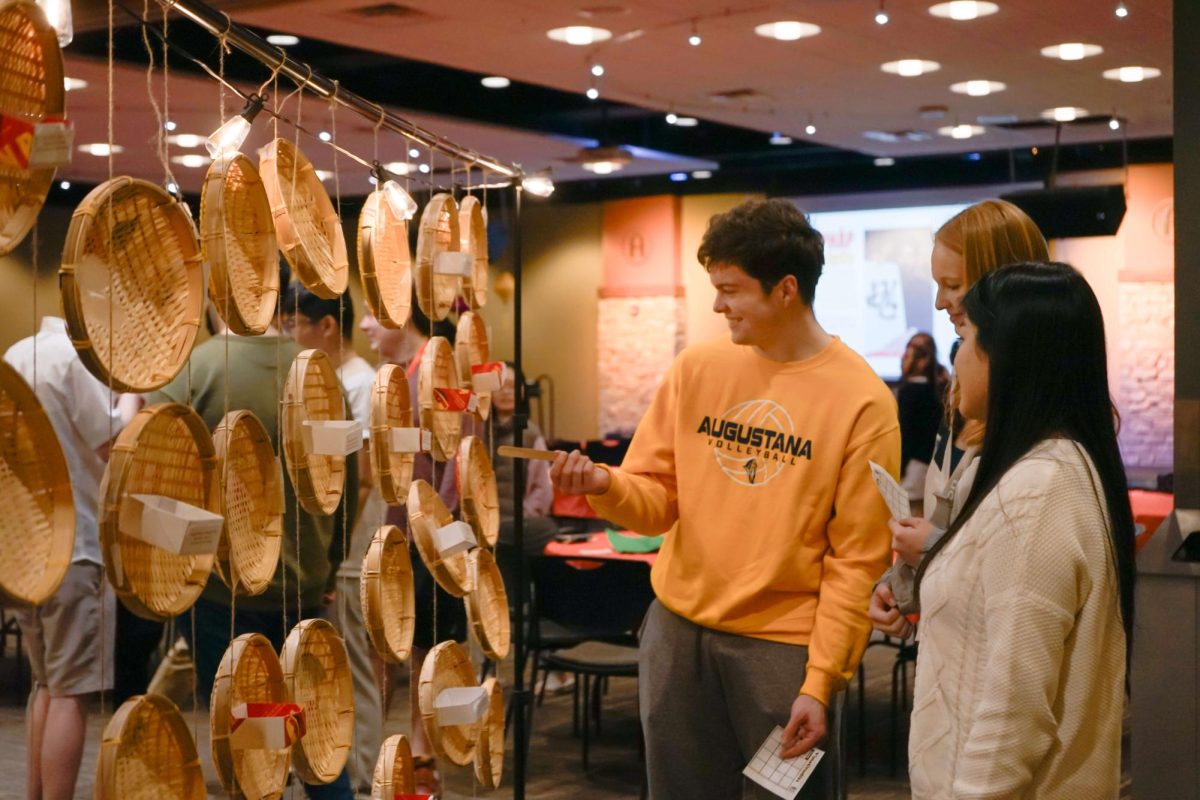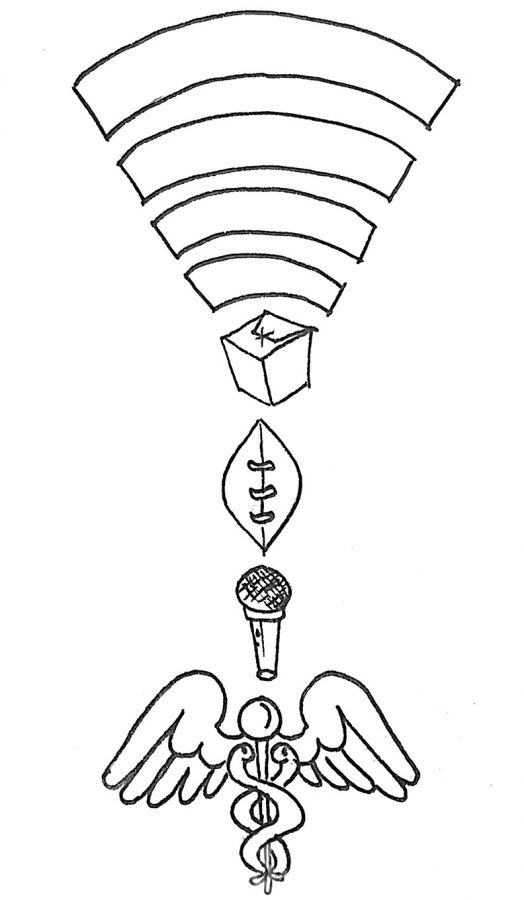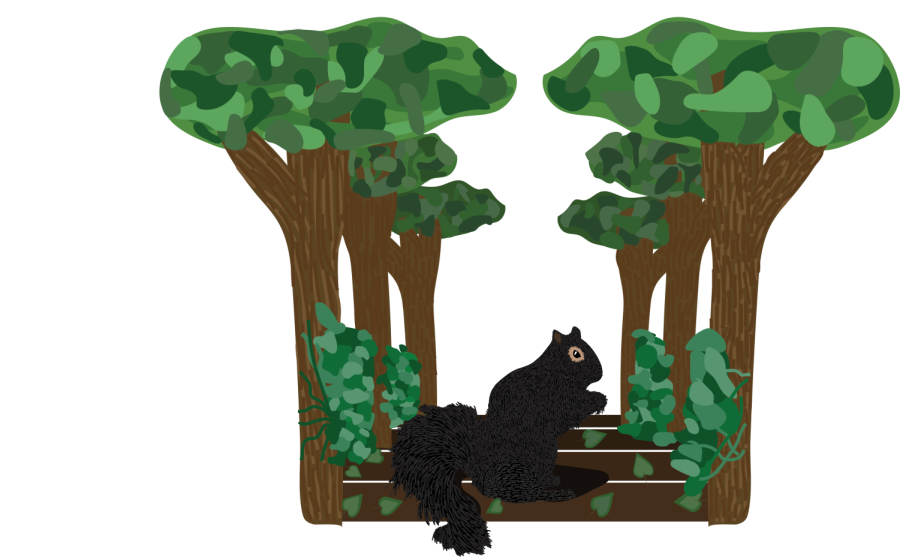The black squirrel: Augustana College’s unofficial mascot
May 17, 2023
When first touring Augustana as a prospective student, one of the most striking things noticed around campus are the black squirrels.
Before coming to Augustana, many people are unaware of the existence of black squirrels. They then often find themselves taking photo upon photo of the little creatures to send back home.
The campus-wide fascination with these creatures raises the question of where they came from. The answer to that question is ultimately unknown by those on campus, but there are a few interesting theories.
In discussing the animals with Brian Leech, associate professor of history, he said that these squirrels can be found outside of Augustana. Although a lot of people encounter them for the first time when they arrive on campus, they are not necessarily unique to the area.
“You can find Eastern gray squirrel populations that have a lot of black members if you go all around the Great Lakes Basin,” Leech said.

With their presence distributed around the Great Lakes, why do so many of them call Augustana home? There’s not an answer specifically for the college campus, but there are stories for how they reached the area in general.
“I would say that the kind of fun to them as a story is that in the Quad Cities especially, I’ve run across all sorts of fun myths and mythos about them in terms of how they show up, like when they’re introduced,” Leech said.
There are a couple of tales describing how the squirrels reached the Quad Cities, neither of which necessarily have truth or accuracy to them, according to Leech.
“One is something pretty weird,” Leech said. “A prince came to visit the area sometime in the 19th century and dropped off squirrels.”
This story is mostly tied up in legend, and is the most common legend people come across when they go to research the squirrels themselves, according to Leech. However, that is not the only tale to be told about them.
The second story isn’t about a prince, but it does involve the squirrels being let loose in the surrounding area. This version has some more credibility, Dr. Leech says, but it’s still undetermined if it’s fact.
“There’s a story connected to Palmer College of Chiropractic across the river,” Leech said. “That story comes from one of the Palmer family, David Palmer, [and] you can find this in his book.”
The written account of this story makes it seem more believable than the other one and it being written also makes it heard (or read) more often.
“The story is essentially [that] he treated someone, the person then gave him a gift of black squirrels to give to the Quad Cities, [and] they were released on Arsenal Island,” Leech said.
Releasing the squirrels on an island doesn’t explain their presence elsewhere though. If populations of black squirrels are seen all around the Great Lakes, then they had to have moved from the island.
This is where an additional story furthers the squirrels’ journeys. It explains their island escape.
“One winter when it iced over between the island and Rock Island, they all jumped over,” Leech said.
Now this story also isn’t proven, it’s just more commonly believed as it’s
written in a book. However, it’s interesting that ultimately the origins of these creatures in the Quad Cities remains a mystery.
“I don’t understand why they would take them to the Arsenal Island of all places to release them, there’s not a lot of explanation for that,” Leech said. “Which is one reason why I’m not sure it’s anything more than apocryphal but I think that’s a fun story to recount.”
Besides the stories of how the squirrels came to the area, it’s interesting to consider the fascination with these creatures. Squirrels are active, fast, and this constant energy makes them fun to watch as they’re running around campus.
Squirrels actually used to be household pets. While they shouldn’t be anymore, they were once thought of to be a “training pet” of sorts and that’s what Dr. Leech finds most interesting about squirrels.
“My favorite thing about squirrels is that there was a long period in the 18th and 19th centuries, when they were one of the major household pets,” Leech said. “And of course, the problem with them as pets is that…no one ever figured out how to truly domesticate a squirrel.”
It’s fun to imagine a squirrel taking the place of a cat or dog in today’s household as they would be an energetic companion, but then again, they’d likely be in a lot of trouble. Squirrels are not meant to be inside creatures and that’s likely what led to the abandonment of them as a common pet.
“Increasingly, by the end of the 19th, early 20th centuries, they just became seen more as pests than they were pets,” Leech said.
Beyond the history of how the squirrels came to be in the area, there’s a history of the students of Augustana being curious about the creatures. The Observer featured them in writing multiple times, special collections librarian Micaela Terronez said.
“Through some of the research I saw, especially like in the 90s and early 2000s, the black squirrels were talked a lot about [and] it was usually very sarcastic, satire stories,” Terronez said. “Then there were a couple talking about how they would take over the world one day.”
These animals have been fascinating the student body for a while, apparently accompanied with a dramatic flare. The squirrels have their own sort of superhero (or villain) origin story in past Observer articles it seems.
“One of the articles included a cartoon of your average squirrel sitting in the tree, and then they jump into the Slough,” Terronez said, “And then once they’re in the Slough and come out of it, they’re like, contaminated and it’s like now they’re the black squirrel.”
This provides another fun story for the squirrels on campus, and this one has a direct connection to the squirrels seen running around campus.
To go more into the ecological aspects of the black squirrels, the squirrels are exactly the same as their eastern gray counterparts, just with different pigmentation in their fur.
Despite this being the only difference between the two, the darker fur color has given black squirrels unique challenges and advantages over their gray counterparts.
For example, the black squirrels are easier to spot by predators during the daytime. This can lead to the population decreasing more than their gray counterparts, who more easily blend into the foliage of the leaves.
One advantage that they hold over their gray squirrels however is their capacity to hold heat. As shown in a 2009 research paper concerning antelopes, black fur allows animals to absorb more heat. Therefore, due to the pigment change, black squirrels are more adept at surviving cold winters, since their fur enables them to absorb more heat, especially when compared to eastern gray squirrels.
This is also the reason why it is rarer to see black squirrels the further south you travel. Their ability to absorb heat in the winter means that they also absorb more heat in the summer, which could lead to heat stress.
This doesn’t mean that there are no black squirrels down south, however. In a research paper published by Current Zoology, two researchers from the University of Georgia found that on average, the width of the black squirrel hairs were smaller in order to compensate for the fact that they hold more heat.
Other than those two differing characteristics, very little differences between the two groups of squirrels have been found.
Although some online sources have proposed that black squirrels are more aggressive than other color variations of eastern grays, all other research conducted has shown that there is no correlation between pigmentation and aggressiveness.
While the differences between eastern gray squirrels and black squirrels are almost purely cosmetic, the black squirrels have become, at least in my opinion, an important part of the identity of the
Quad Cities.






















































































































